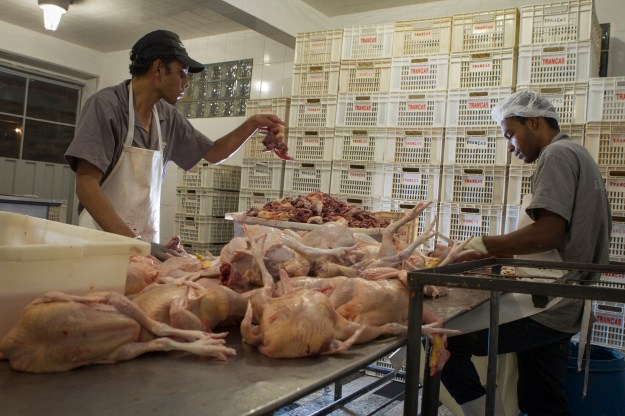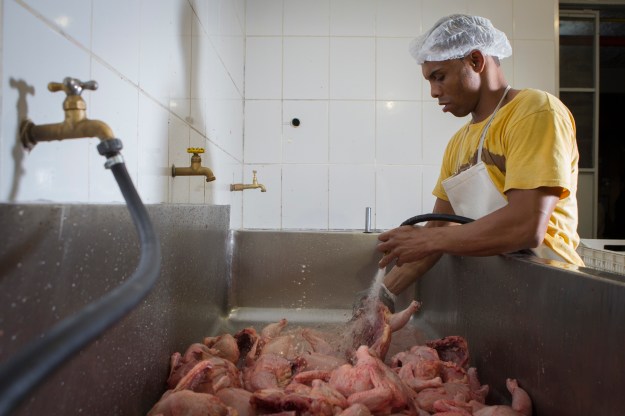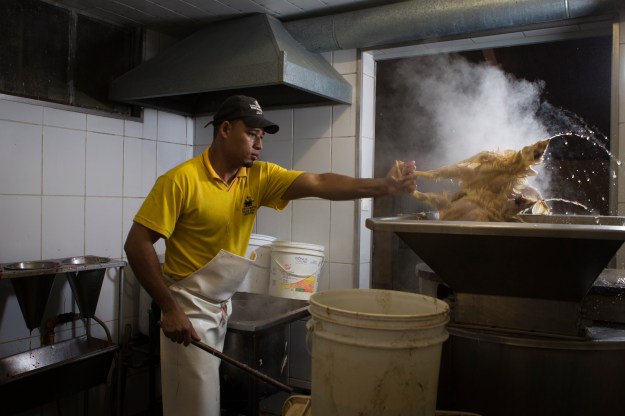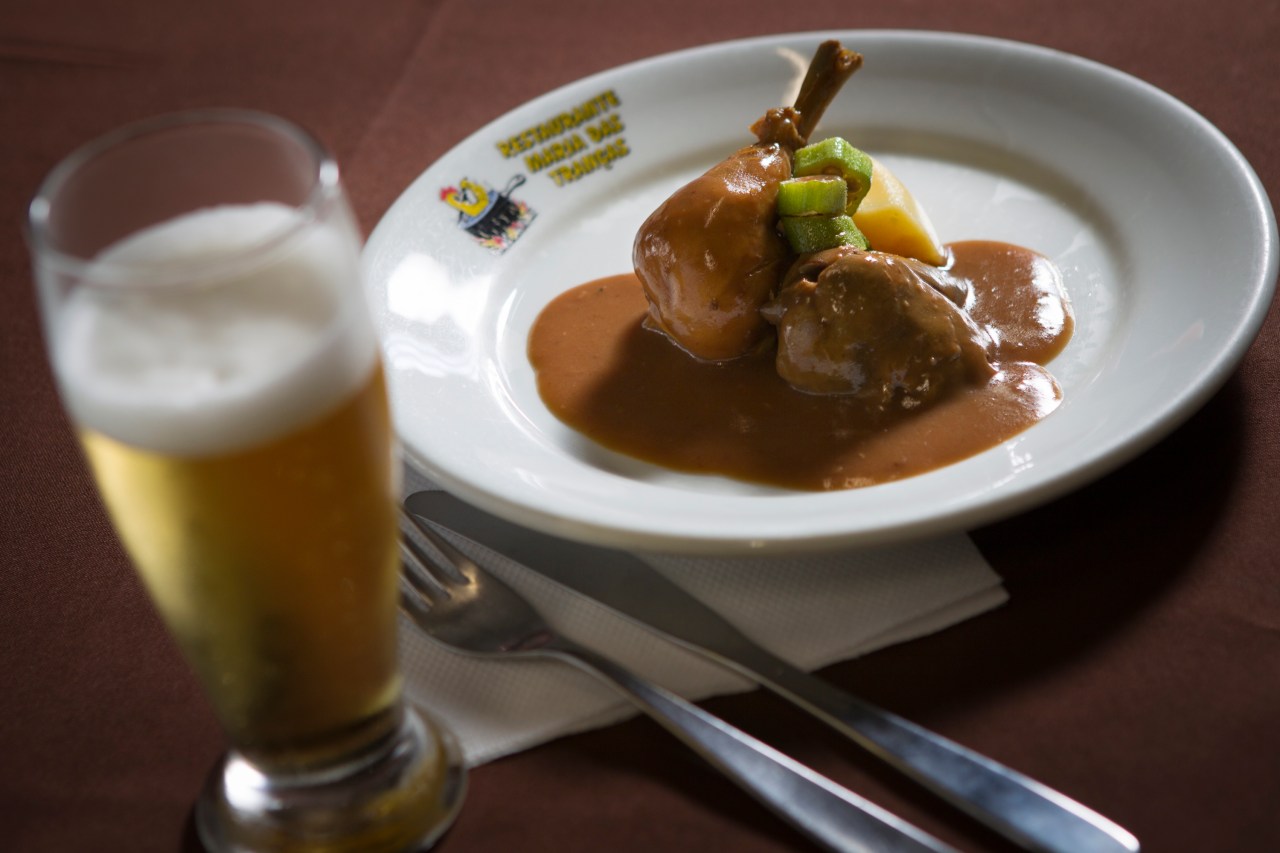Behind a brick facade on a residential street in the Brazilian city, Belo Horizonte is a small abattoir with a restaurant attached.
The setup may be unusual, but it supplies the owners of Maria das Tranças with the only legal means to provide the establishment’s patrons with a dish that many are prepared to wait two hours for: galinha ao molho pardo.
Consisting of chicken cooked in a thick broth made from the animal’s own blood, the recipe came to Brazil via Portuguese colonizers in the 16th century. But in recent years it has largely disappeared from menus, primarily because fresh-blood sales are unregulated in many Brazilian states and banned without proof of origin.
Without Maria das Tranças, Brazil would be at risk of losing completely one of its most famous culinary traditions.
Situated in San Fernando, a longtime rural area that is becoming residential, the 68-year-old restaurant claims it is the only commercial venue in the South American country where the dish can be prepared and sold without running afoul of the law.
On Saturdays and Sundays customers line the street in front of a small side door, many in the queue armed with empty pans. The vessels are used to transport the classic dish to waiting families back home.
Meanwhile, inside the establishment, patrons tuck into a well-seasoned dish with a velvety brown sauce that, despite its main ingredient, does not taste of blood. To Talita André, a frequent customer, it is a reminder of her upbringing: “It’s a comforting and hearty food, reminiscent of a loving tradition. Since I can no longer taste my grandmother’s and it is very difficult to find, I come here to remember the good old times.”
Ricardo Rodrigues is the third generation in his family to run the business. When cooking galinha ao molho pardo, he follows the exact same recipe his grandmother, Maria Clara Rodrigues, handed down to him.
Maria Clara prepared her signature dish by killing the chicken herself. She snapped the animal’s neck and dripped the dead bird’s blood into a bowl, to be used later while preparing the sauce. The dish is commonly served with rice, angu (a side dish of cooked cornmeal, similar to polenta), and okra.




The family matriarch opened her first restaurant, Bolero, in 1950. Later renamed Maria das Tranças (Braided-Hair Mary, a nod to the owner’s distinctive locks), Maria Clara continued to prepare the dish in her traditional way.
But things have changed since Maria Clara began dishing out piping-hot plates of galinha ao molho pardo. The tradition may be alive in many homes in Minas Gerais and other regions of the country, but not in the restaurant trade.
The Brazilian Ministry of Agriculture, Livestock, and Food Supply requires that the product will have no risk of contamination until reaching the plate. And proving that is prohibitive for most small businesses. To keep the establishment going and aboveboard in the eyes of the authorities, it was necessary to build a slaughterhouse on the premises. The blood is stored in a refrigerator immediately after the animal is killed, and it is kept there until the dish is prepared.
“We had to apply for a license for the slaughterhouse and yet another one for processing the meat,” Rodrigues explains.
“As a consequence of the new requirements from the government, all restaurants had to stop making the galinha ao molho pardo. We were allowed to continue only because of our investments to make it possible.
“We made this effort in memory of my grandmother and in honor of one of the richest Brazilian culinary traditions,” he adds.
Every week the restaurant, which seats some 560 people, serves around 2 tons of chicken. The birds are raised in an area of the San Fernando neighborhood that more closely resembles a poultry farm.
“Nine out of 10 of our orders are for the galinha ao molho pardo,” Rodrigues says. They also serve four other chicken dishes, but none has come close to outselling the restaurant’s most popular dish.
The success of Maria das Tranças led to a sister restaurant opening in Savassi, a wealthier neighborhood in downtown Belo Horizonte. At this second venue they dish out around 1,000 servings of galinha ao molho pardo every week.
“We welcome people from all over Brazil and the world. There are always foreigners here. Last week we had a person over from the Netherlands who came to Belo Horizonte specially to taste our chicken,” Rodrigues says.

While at Maria das Tranças they use fresh blood, other restaurants serving galinha ao molho pardo have resorted to buying frozen blood—often in a clandestine way, in light of the law. It is “as if they were trading drugs,” Rodrigues says.
But Rodrigues believes that the use of the blood should be like that of any other part of the bird. “We need laws that control manufacturing and food safety, not laws that prohibit this ingredient from being used,” he says.
Chef Jefferson Rueda agrees. Born in São Jose do Rio Pardo, a city across the Minas Gerais border in the interior of the state of São Paulo, Rueda has fond memories of eating galinha ao molho pardo as prepared by his mother and aunts during his childhood. When he became a well-known chef in São Paulo, he hoped to replicate the dish at Attimo, his former restaurant.
Faced with the same restrictions as other chefs, Rueda could have fallen back on using morcilla—a widely available blood sausage—as a substitute for the chicken blood. Since it is processed before leaving the factory, morcilla does not contravene Brazilian law.
But Rueda wanted to use the real stuff. As such, he created the Sangue é Ingrediente (Blood Is an Ingredient) campaign and mobilized other chefs to lobby the government over the rules. Started in 2014, the campaign encourages cooks to post pictures from recipes prepared with blood and positioning the ingredient as a tradition in Brazilian cuisine.
“In many countries, animal’s blood is widely used to cook many traditional recipes,” he says, citing poulet en barbouille and boudin noir in France, black pudding in the U.K., and the Filipino dish dinuguan as examples.
“Here in Brazil our legislation needs to understand tradition,” Rueda says, adding: “Simply banning the blood’s use is not going to help us get anywhere.” According to the chef, consumers need to have a connection with the whole animal as part of the eating experience—the creature’s origins and the process it passes through on the way to the plate. Decades ago it was common to kill and eat the whole animal—meat, innards, blood, and all. Today it is a rarity.
Even if the campaign does not overturn local laws, it has had at least one beneficial outcome for Rueda. Through it he has gotten to know Hugo Orrico, a farmer who raises free-range chickens, among other activities, and is applying to get approval to sell their blood. The produce is filtered and mixed with a little apple-cider vinegar to avoid coagulation; therefore it isn’t deemed “fresh blood” and can be sold, Orrico explains. Chef Rueda says the end product is perfect for the molho pardo and hopes to incorporate it into his recipes as soon as Orrico’s license arrives.
“It’s a long and bureaucratic process, but I can hardly wait to use the blood, as well as see other chefs doing the same,” he says.
Orrico’s blood went to market in December. For now one of the only ways to taste the recipe using fresh blood is to frequent one of Rodrigues’ restaurants or take a trip to the interior of the state, where many farm families maintain the habit of killing chickens themselves and using the blood to make the tasty brown sauce. Thanks to them, the tradition is being perpetuated through generations of families who, like Rodrigues, know that blood is thicker than water.